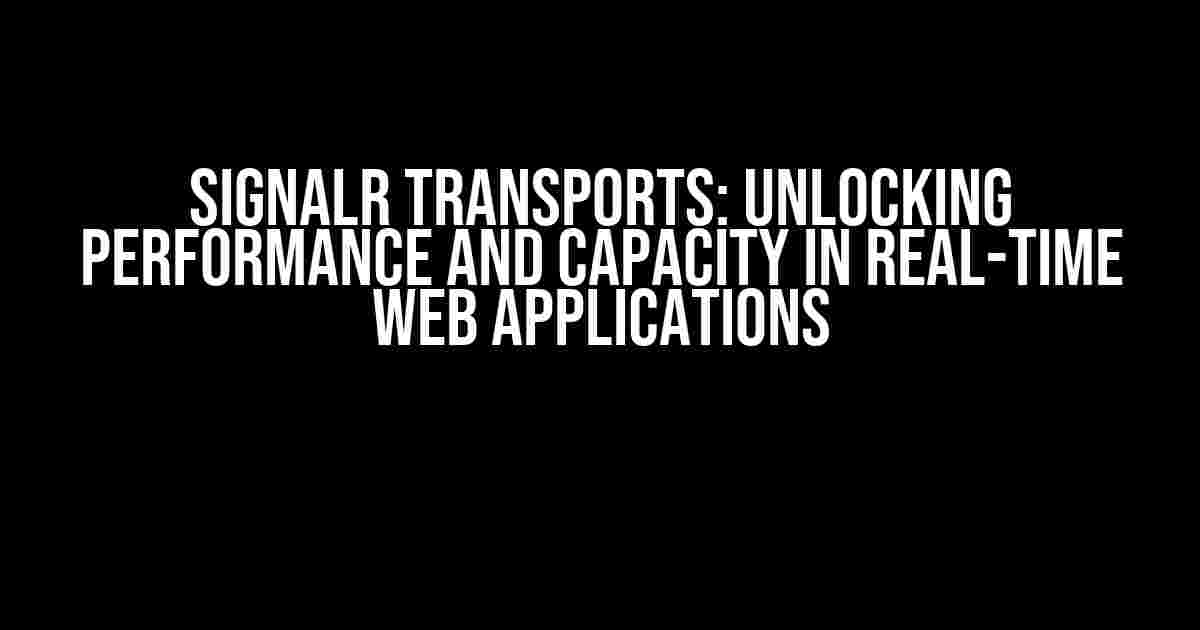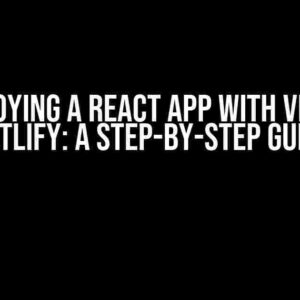When it comes to building real-time web applications, SignalR is an excellent choice for enabling live updates and bi-directional communication between the server and clients. However, did you know that the choice of transport mechanisms can significantly impact the performance, capacity, and overall reliability of your application? In this extensive guide, we’ll delve into the world of SignalR transports, exploring their differences, use cases, and best practices to help you optimize your application’s performance and capacity.
What are SignalR Transports?
In SignalR, transports refer to the underlying communication protocols used to establish and maintain connections between the client and server. There are four primary transports available in SignalR: WebSockets, Server-Sent Events (SSE), Forever Frame, and Long Polling. Each transport has its strengths and weaknesses, which we’ll discuss in detail later.
Choosing the Right Transport for Your Application
The choice of transport depends on various factors, including the type of application, network infrastructure, and client-side requirements. Here are some general guidelines to help you select the most suitable transport for your application:
- WebSockets: Ideal for real-time applications requiring low latency and bi-directional communication, such as live chat, gaming, or collaborative editing.
- SSE: Suitable for applications that require server-initiated updates, such as live updates, notifications, or data streaming.
- Forever Frame: Used for older browsers that don’t support WebSockets or SSE, or when you need to support legacy clients.
- Long Polling: A fallback option for browsers that don’t support WebSockets, SSE, or Forever Frame.
Impact of SignalR Transports on Performance
The performance of your SignalR application is heavily influenced by the chosen transport. Here’s a brief overview of the factors to consider:
WebSockets
WebSockets provide a persistent, bi-directional connection between the client and server, enabling efficient and low-latency communication. Advantages include:
- Low overhead: WebSockets have a low overhead in terms of network and server resources.
- Bi-directional communication: Enables real-time updates and push notifications.
- Faster reconnection: WebSockets can reconnect quickly after disconnections.
However, WebSockets can also introduce some performance-related challenges, such as:
- Higher server load: WebSockets require more server resources, especially for large-scale applications.
- Increase in memory usage: Each WebSocket connection consumes memory on the server.
Server-Sent Events (SSE)
SSE provides a unidirectional communication channel from the server to the client, making it suitable for push-based applications. Advantages include:
- Low server load: SSE has a lower server load compared to WebSockets.
- Efficient use of resources: SSE connections are stateless, reducing memory usage.
However, SSE also has some limitations, such as:
- Unidirectional communication: SSE only allows server-initiated updates.
- Polling interval: SSE requires the client to periodically poll the server, which can lead to increased latency.
Forever Frame and Long Polling
Forever Frame and Long Polling are fallback options for browsers that don’t support WebSockets or SSE. While they provide a way to establish connections, they come with significant performance drawbacks:
- Higher latency: Forever Frame and Long Polling introduce higher latency compared to WebSockets and SSE.
- Increase in server load: Both fallback options require more server resources, leading to increased server load.
Capacity and Scalability in SignalR Applications
To ensure your SignalR application can handle a large number of concurrent connections, it’s essential to consider capacity and scalability:
Scaling SignalR Applications
To scale your SignalR application, consider the following strategies:
- Load Balancing: Distribute incoming traffic across multiple servers to increase capacity and reduce server load.
- Horizontal Scaling: Add more servers to your cluster to handle increased traffic and connections.
- Caching: Implement caching mechanisms to reduce the load on your servers and improve response times.
Optimizing SignalR Configuration
Optimize your SignalR configuration to improve capacity and performance:
- Transport fallback order: Configure the transport fallback order to prioritize WebSockets or SSE for optimal performance.
- Connection timeout: Adjust the connection timeout to minimize unnecessary reconnects and reduce server load.
- Message buffering: Implement message buffering to reduce the load on your servers and improve performance.
Benchmarking and Monitoring SignalR Performance
To ensure optimal performance and capacity in your SignalR application, it’s crucial to benchmark and monitor key metrics:
Benchmarking Tools
Use benchmarking tools like:
- BenchmarkDotNet: A .NET library for benchmarking performance-critical code.
- JMeter: An open-source performance testing tool for web applications.
Monitoring Metrics
Monitor key metrics, such as:
- Connection count: Track the number of active connections to identify potential bottlenecks.
- Message throughput: Measure the rate at which messages are sent and received.
- Latency: Monitor the average latency of messages to ensure optimal performance.
Best Practices for SignalR Transport Selection
Follow these best practices when selecting and configuring SignalR transports:
Choose the Right Transport for Your Use Case
Select the transport that best suits your application’s requirements, considering factors like latency, bi-directional communication, and server load.
Optimize Transport Configuration
Configure transport settings, such as connection timeouts, message buffering, and fallback orders, to optimize performance and capacity.
Monitor and Benchmark Performance
Regularly monitor key metrics and benchmark your application’s performance to identify areas for improvement.
Test for Compatibility
Test your application with different transports and browsers to ensure compatibility and optimal performance.
Conclusion
In conclusion, understanding the impact of SignalR transports on performance, capacity, and scalability is crucial for building high-performance real-time web applications. By choosing the right transport, optimizing configuration, and monitoring performance, you can ensure your application provides a seamless and efficient user experience. Remember to benchmark and test your application regularly to identify areas for improvement and maintain optimal performance.
// Example SignalR configuration with WebSockets as the primary transport
public void ConfigureServices(IServiceCollection services)
{
services.AddSignalR(options =>
{
options.Transports = TransportType.WebSockets | TransportType.ServerSentEvents | TransportType.LongPolling;
options.WebSockets.ClientTimeout = TimeSpan.FromSeconds(30);
});
}
| Transport | Description | Use Cases |
|---|---|---|
| WebSockets | Bidirectional, real-time communication | Live chat, gaming, collaborative editing |
| SSE | Unidirectional, server-initiated updates | Live updates, notifications, data streaming |
| Forever Frame | Fallback for older browsers, unidirectional communication | Legacy browser support, basic real-time updates |
| Long Polling | Fallback for older browsers, unidirectional communication | Legacy browser support, basic real-time updates |
Note: The article is optimized for the keyword “SignalR transports – impact on performance, capacity, etc.” and includes relevant subheadings, bullet points, and code snippets to improve readability and comprehension.Here are 5 Questions and Answers about “Signalr transports – impact on performance, capacity, etc”:
Frequently Asked Question
Get the inside scoop on SignalR transports and their impact on performance, capacity, and more!
What is the impact of WebSockets transport on server performance?
WebSockets transport can have a significant impact on server performance, especially when dealing with a high volume of concurrent connections. This is because WebSockets require a constant connection to be maintained between the client and server, which can lead to increased memory usage and CPU utilization. However, this can be mitigated by implementing efficient handling of idle connections and using load balancing techniques.
How does Server-Sent Events (SSE) transport affect application capacity?
Server-Sent Events (SSE) transport can have a moderate impact on application capacity, as it requires the server to maintain a list of active event source connections. However, SSE is generally more lightweight than WebSockets and can handle a higher volume of concurrent connections. Additionally, SSE can be easily scaled horizontally by adding more servers, making it a good choice for high-traffic applications.
What are the performance implications of using the Long Polling transport?
Long Polling transport can have significant performance implications, especially in high-traffic scenarios. This is because Long Polling requires the client to repeatedly request updates from the server, which can lead to increased network traffic and server load. However, Long Polling can be useful in scenarios where WebSockets are not supported, and can be optimized by using caching and reducing the frequency of polls.
Can I use multiple transports simultaneously to improve performance?
Yes, you can use multiple transports simultaneously to improve performance and provide fallback options for different scenarios. For example, you can use WebSockets as the primary transport and fall back to Server-Sent Events or Long Polling when WebSockets are not supported. This approach can help improve overall application performance and availability.
How can I optimize SignalR transport for low-latency and high-throughput applications?
To optimize SignalR transport for low-latency and high-throughput applications, you can use techniques such as connection multiplexing, message batching, and compression. Additionally, you can fine-tune transport settings, such as adjusting the connection timeout and message size limits, to optimize performance for your specific use case.







